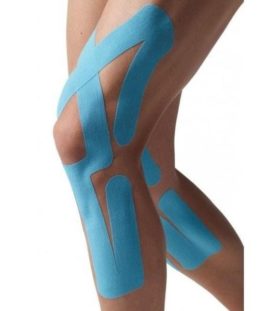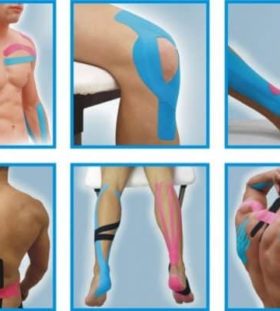Cutting Different Types of Kinesiology Tape
Kinesiology tape is a form of treatment that has been used for many years in physical therapy and sports medicine clinics. It is often used to help facilitate muscle function, stabilize joints, and prevent muscles from contracting improperly. In addition, it can also help athletes decrease pain, swelling, as well as muscle spasms.
While kinesiology tape can be applied at home, it is important to understand why you are using the tape so you can get the best use out of it. Consider seeing a physical therapist, who will be able to conduct an evaluation and assessments of your problem areas, and show you the correct taping techniques that suit your individual needs.
It is crucial that you apply the right type of kinesiology tape strips that are specific to the problem that you are facing. Having an understanding of the different types of Kinesiology tape strips that can be used and how to cut them will ensure that you are using the tape properly.
Remember that bodies come in different shapes and sizes, which means that you may have to improvise to get the tape to work for you. Working collaboratively with your physical therapist will help you to understand what kinesiology tape strips you should be using.
Successfully applying kinesiology tape is both a science and an art. From the scientific perspective, it requires a thorough understanding of anatomy, the mechanisms of unjust, and the goals of different taping techniques. From the artistic perspective, it requires the user to design and cut the best taping techniques for them.
Table of Contents
How Does Kinesiology Tape Work?

When your muscles are sore or swollen, the body’s natural response is swelling, as blood and white blood cells rush to the injured area to repair it. Oftentimes, the swelling leads to pain and inability to perform physical activities. Kinesiology tape, due to its elasticity, allows users to have their full range of motion. The elasticity of the tape lifts the skin from the muscle, effectively relieving pressure from the affected area.
The great thing about kinesiology tape is that it is water-resistant, which means it can be worn for up to five days, even through showers or sweating.
Kinesiology tape is not like traditional athletic tape, which is usually in a roll and the user tears off a strip and wraps it around their injured area. Kinesiology tape is much more versatile and intricate. To achieve the best results, a number of “cuts” can be used.
Different Ways Of Using Kinesiology Tape
The “I” Strip
The “I” strip is the most common kinesiology tape. It can be used to relieve pain after a muscle injury, reduce swelling and irritation, and mechanically correct improper movement patterns. Athletes will use it for muscle facilitation and inhibition. The “I” strips are used to help support muscles, tendons, and ligaments. They can be applied to the gluteus muscles, quadriceps, or Achilles tendon.
In order to make an “I” strip, cut the amount of kinesiology tape that you will need. To prevent the tape from being easily removed, make sure that you’re cutting around the edges.
Place the “I” strip over the area of injury or pain. You will know the taping is complete when the area where the tape has been placed appears convoluted and shows a lifting action of the tape on the skin.
The “X” Strip
The “X” strip is used on muscles that cross two joints. In order to cut an “X” strip, first place the muscle that you are planning on placing the tape on in a position of maximum stretch. Next, measure the length of the tape that you will need to cover the entire muscle. Cut a piece of kinesiology tape that is slightly longer than the muscle. The third step is to cut down to the middle from each end towards the centre, making sure to leave the centre portion intact. Don’t forget to round the edges to prevent fraying.
To apply the “X” strip, stretch the centre portion of the tape and place it over the muscle. Make sure to rub the tape in order to activate the adhesive. Take one tail at a time and remove the backing in order to apply them with no stretch around the affected muscles.
The “Y” Strip
The “Y” strip is commonly used to cross over sensitive areas of the body, such as behind the knee or the front of the elbow. It can be used to facilitate the activation of weak muscles to help them contract more effectively, reduce pain and inflammation, and soften scar tissue. To create a Y shape, cut a piece of kinesiology tape approximately 2” longer than the muscle. Next, cut the tape from one end to the other, leaving a couple in inches still intact. Remember to round the edges to prevent them from catching or loosening prematurely.
“Y” shaped kinesiology tape should be applied slightly above or below the muscle being taped. The two tails of the “Y” should be applied along the outer borders of the muscle.
Important Tip: The “Y” strip is not as long as the “X” strip.
The Fan
The Fan is another type of kinesiology tape cut that is used to control swelling in the arms and legs. In many instances, more than one fan strip will be used with tails overlapping in different directions.
In order to make a fan, cut an “I” strip and then make three cuts lengthwise. This creates four small strips that you can spread out over the swollen area.
To apply a fan strip, remove the backing, and apply with no stretch above the lymph node, where you want fluid to be directed. Put your muscle into a stretch position in order to apply the tails. Peel the backing from the strips and apply them with a light stretch along the outer edges of the swelling.
Some Helpful Tips for Using Kinesiology
- Most kinesiology tapes are made for simple applications. This means that if you are applying the tape and you mess up, you may need to start over with a new piece.
- Before applying the tape, make sure there is no hair on the area where it will be applied. Short hair won’t impact the application or removal process, but thicker hair will make the tape more difficult to put on and remove.
- To reduce any pain, remove the tape in the same direction as hair growth.
- Avoid excessive heat when applying the tape, as it can make the tape difficult to remove.
If you have an injury that decreases your motion or function, your physical therapist will be able to teach you more about kinesiology tape and how it can be used to treat your condition.
SpiderTech offers a wide range of kinesiology tape that includes i-strips, pre-cuts, rolls, and powerstrips. Whether you are experienced in the world of sports, or just beginning your fitness journey, kinesiology tape will ensure that nothing holds you back from crushing your goals.
I am an Author and what makes me the one is my ability of playing with the words. I also enjoy writing poetry and engaging my audience in my words. I have written for many websites and eBook and gained a good response.

 Tagged:
What are the different types of KT Tape?, Which kinesiology tape is best?
Tagged:
What are the different types of KT Tape?, Which kinesiology tape is best?
